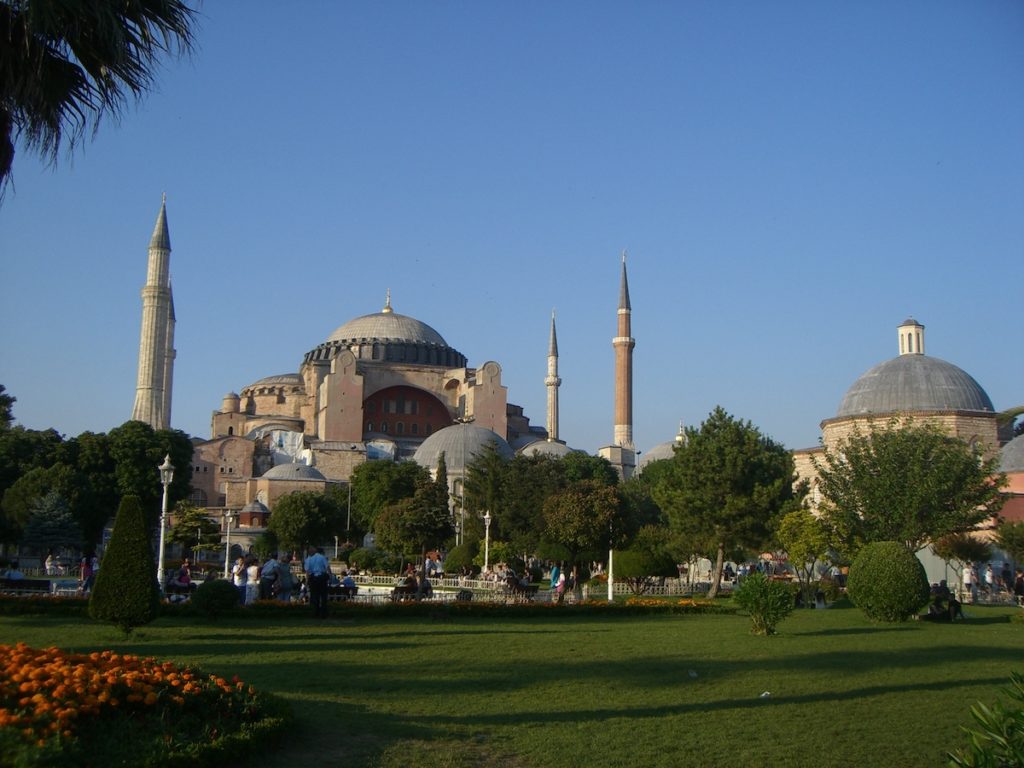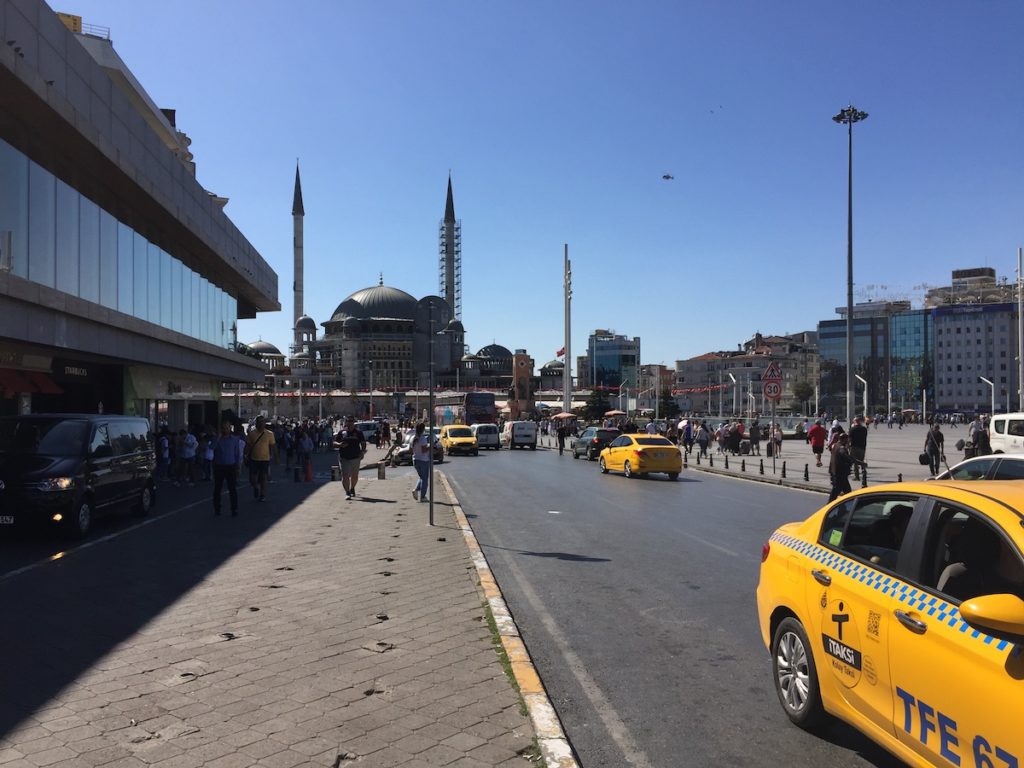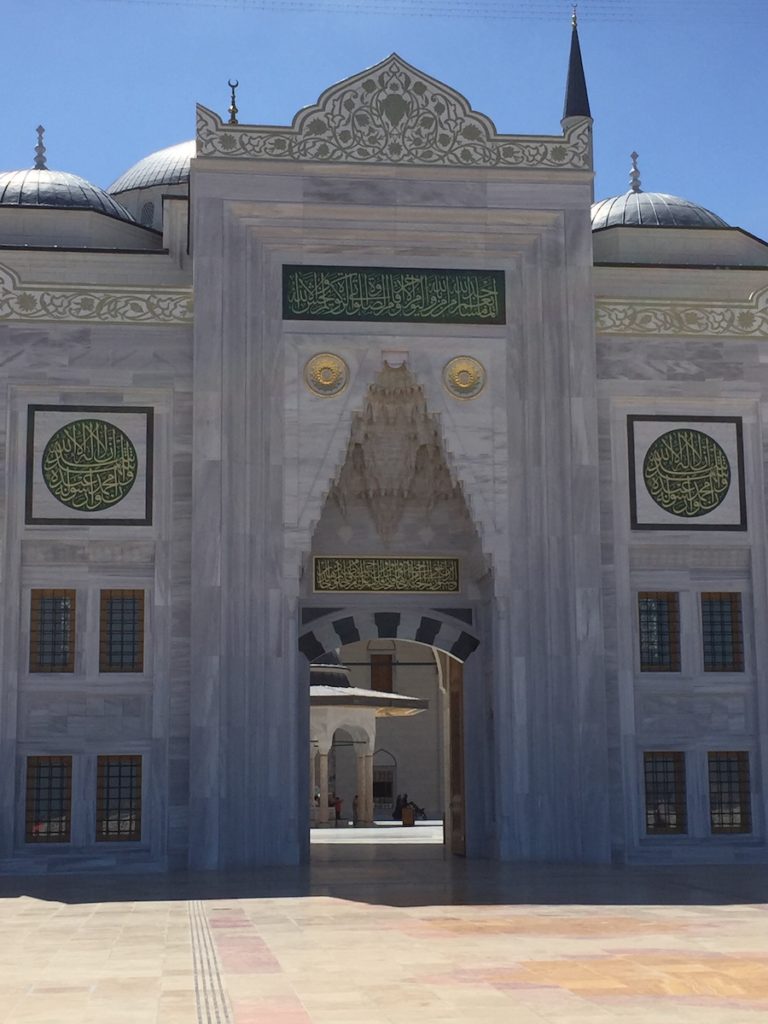The recent news about Hagia Sophia’s reconversion from a museum to a mosque has generated a flood of commentaries and discontent. This is not the first time that Istanbul’s architectural treasure has been treated as a vector of contemporary ideology (Fig. 1). Yet both the national and international media ignore the history of the intervening centuries that make up Hagia Sophia’s multifaceted identity and fuse the current situation with the Justinian foundation of the building in the sixth century to pronounce contempt for conservative Turkish politics. This omission not only risks sounding Orientalist, but also plays directly into the hands of ultra nationalists, with whom the AKP, Turkey’s ruling party, formed a coalition, and who are equally willing to cast aside almost six hundred years of Ottoman and Turkish stewardship of the building. They see the building’s “return” to a functioning mosque after having served as a museum since 1934 as a reenactment of the city’s conquest in 1453.
The reconsecration ceremony took place on July 24, supposedly to rebuke secularism as the date marks the anniversary of the Lausanne Treaty (1923) that saw the foundation of the modern Turkish Republic and the end of a defunct empire. The critics’ dismay is not that there will be prayers inside the building, since Hagia Sophia’s spiritual charisma has hardly ever been doubted, but that its use as a symbol of Turkey’s Islamist politics denies its centrality to the definition of many identities constitutive of modern Turkey. How exactly, then, may such a symbolically overloaded building be (re)appropriated for a single use without denying its formal, political, and cognitive pluralism? The magnificence and real potential of Hagia Sophia for genuine open-ended collective identity demands historical lucidity, not amnesia.
Inherited from Byzantium, Hagia Sophia was under the custodianship of the Ottoman Empire for almost 500 years, followed by that of the Turkish Republic for the last century. Today it is as much Byzantine as it is Ottoman and Turkish, not unlike St. Mark’s Basilica in Venice, which is as much Italian as it is Byzantine. Over the centuries, strong rulers like Mehmed the Conqueror (r. 1451-81), Süleyman the Lawgiver (r. 1520-66), Ahmed I (r. 1603-17), Abdülmecid I (r. 1839-61) and Mustafa Kemal Atatürk (President from 1923-1938) had the power to determine its status through rhetoric and material interventions. Consequently, since 1453 Hagia Sophia has successively served as an imperial mosque, a formidable model for Ottoman religious architectural culture, a rival to be challenged, a symbol of Westernization, and, finally, as an icon of a modern Republic with universalist aspirations. Even if not all of the above alterations and polemics represented a decisive break with the key moments in the life of the building, its legacy has always been wrought in direct response to what was happening in the city, as well as changes taking place in political, social, cultural, and aesthetic arenas.

The crucial point being that in this longue durée, Hagia Sophia was never an empty prop or trope of the past to be used at the will of its inheritors.[1] By converting it into a Friday Mosque, Mehmed the Conqueror confirmed his own status as a successor to the Roman emperor Constantine the Great. Süleyman’s chief court architect Sinan “naturalized” its place within Ottoman architectural heritage by designing the Süleymaniye Mosque (1550-57) as its twin. Built on the Hippodrome, the so-called Blue Mosque of Ahmed I (1609-16), with its impressive size and unprecedented six minarets, tried to curb Hagia Sophia’s popularity by overshadowing it (Fig. 2). When in the 1840s Sultan Abdülmecid hired the Swiss-Italian architects, Gaspare and Guiseppe Fossati, to restore the building and preserve its gold mosaics, his plan was to project a modernizing image of the Ottoman Empire. By the end of the nineteenth century, Hagia Sophia—standing in the middle of an archeological park surrounded by no less than four museums mostly converted from old Byzantine and Ottoman buildings—had already become a major tourist destination. In 1934 Ataturk saw its potential as a full-fledged museum in and of the nation-building process, especially its promise for mediating between the local and the universal, the traditional and the modern, the sacred and the secular.[2]
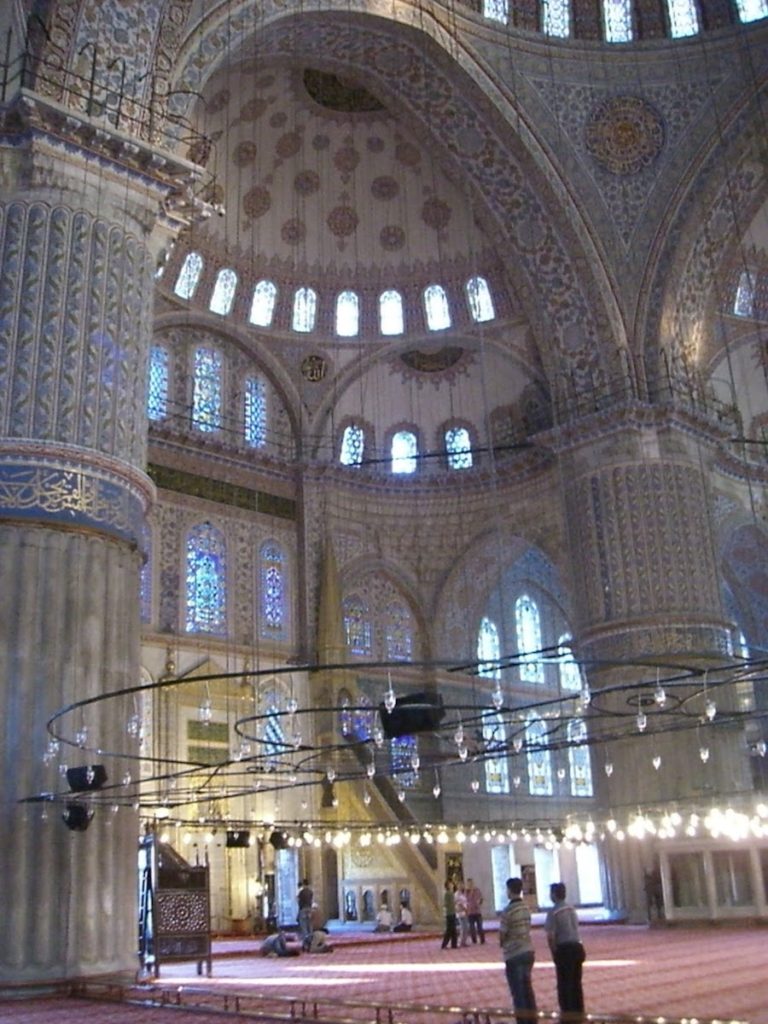
During these statutory transformations, Hagia Sophia’s physical appearance also evolved. A mihrab, a minbar, and a minaret added by Mehmed the Conqueror was followed by a second minaret commissioned by his successor. Amidst the proliferation of minarets in sultanic mosques (i.e. those commissioned by sultans), Hagia Sophia gained two more minarets by the end of the sixteenth century, thus asserting its imperial standing. The building also underwent internal modifications. Ahmed I whitewashed its exquisite mosaics, so they would not overshadow the sumptuous polychrome floral Iznik tiles adorning the walls of his own mosque (Fig. 3). Abdülmecid instead exposed some of them, while at the same time further embellishing the interior with calligraphic disks. After Topkapi Palace’s conversion into a museum in 1924, the Council for the Preservation of Monuments, ordered by Atatürk, turned its attention to restoring the decaying structures of not only Hagia Sophia but also the Blue Mosque.[3]
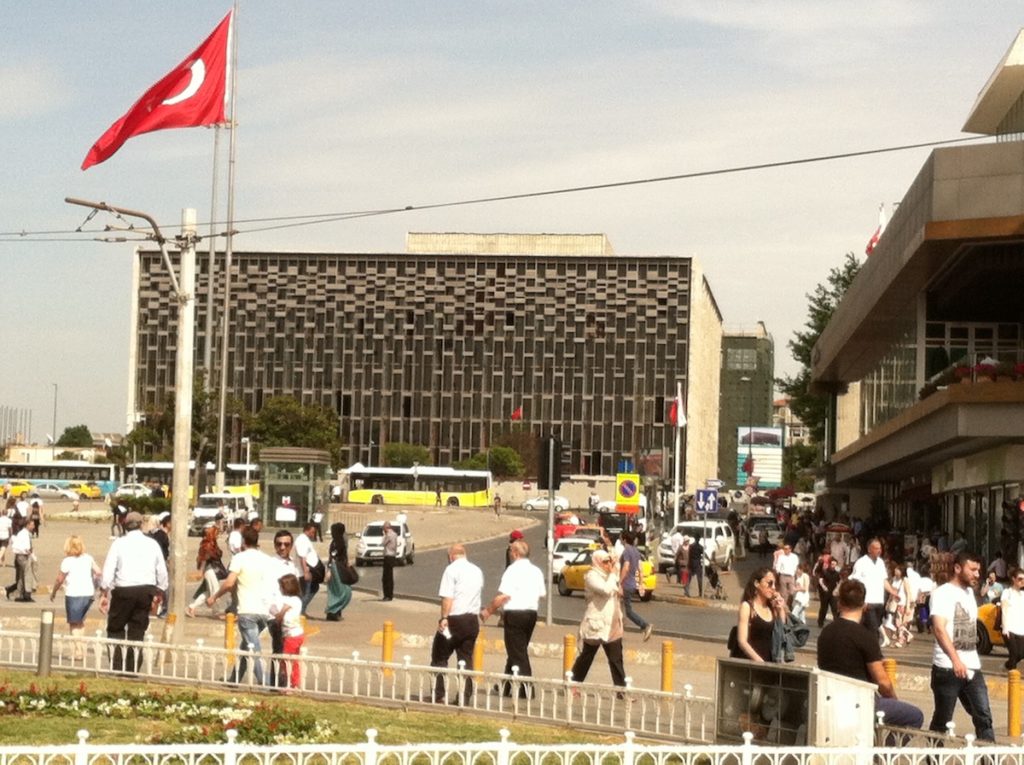
Equally, Hagia Sophia did not stop being part of an evolving society after it was converted into a museum in 1934. In 1980, thirty years after Turkey’s transition to a multi-party system, Prime Minister Süleyman Demirel decided to transform a part of the imperial gallery of Hagia Sophia into a prayer hall, which garnered as much criticism on the Turkish side as from the West. But in today’s polarized climate—with the War on Terror on the one hand, and UNESCO ecumenism on the other—to speak of Islam conjures up not the ‘Turkish Dilemma’ of the 1980s in the context of the republic’s secularist constitution, but the specter of a clash of civilizations. In this polemical conundrum President Recep Tayyip Erdoğan’s role is undeniable. Unlike his predecessors, who were building an empire, a city, or a republic while at the same time striving towards a delicate balance between Islamic confessionalism and pluralism, his cultural politics are dominated by instrumentalization of Islam. Erdoğan deploys a post-modern brand of archaism made of easily recognizable tropes—domes and minarets—to protect his personal power as well as big businesses, thus undoing both the Kemalist ethos and the Ottoman politics of style.
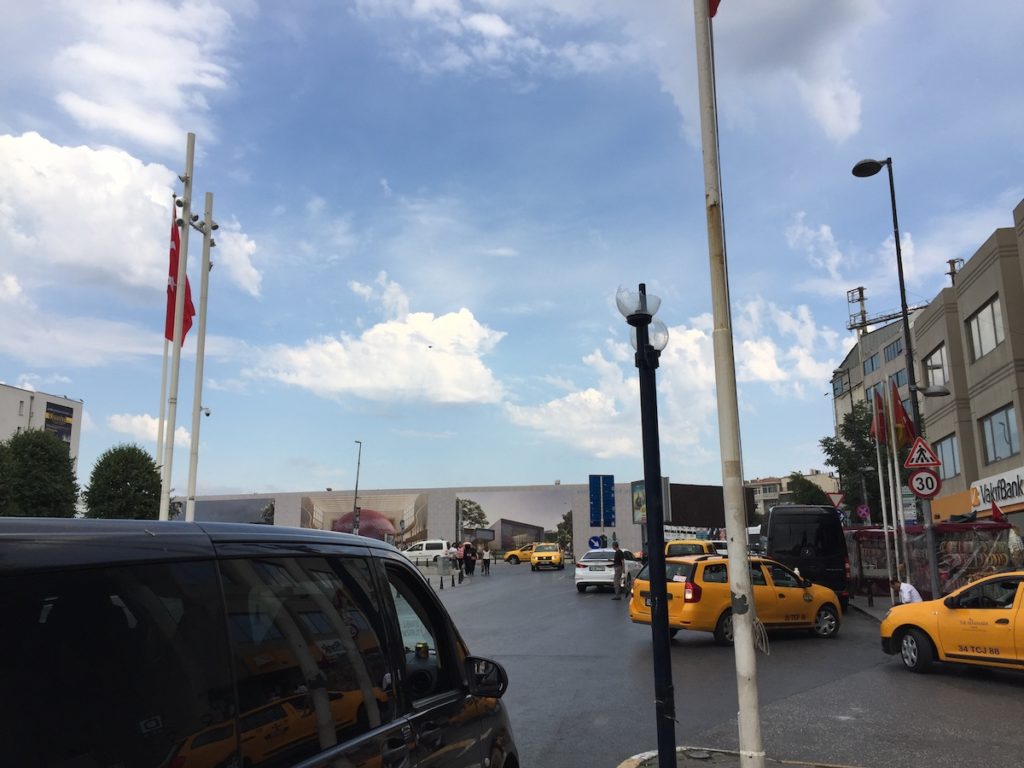
Since the mid-2000s, following the sudden stop in the negotiations for Turkey’s admission to the European Union, Erdoğan devised a new political game of diffusing Ottoman-style mosques worldwide as a counter-effort to symbolize Turkey’s cultural ascendancy. His actions, generally interpreted as imperial nostalgia, have been described as Neo-Ottomanism, which is also apparent in his grand vision for the old capital, Istanbul.[4] Over the last decades, the AKP has been pouring funds into countless pseudo-Ottoman style mosques throughout the metropolis while destroying icons of republican modernism such as The Atatürk Cultural Center in Taksim Square (Fig. 4). This celebrated public square, conceived in opposition to the private sphere of religion, now contains a Neo-Ottoman mosque (Figs. 5 and 6). Using Islamic mores as a basis for urban policies, the regime also forbade the sale of alcohol in certain neighborhoods. Moreover, Erdoğan even emulated the sultanic practice of erecting a colossal mosque on a hilltop (Figs. 7 and 8).[5] Inaugurated in 2019, the Çamlica Mosque is built on the precious little patch of greenery left on the Asian side of the Bosphorous, and modeled after the Blue Mosque. We must therefore see the revocation of Hagia Sophia’s status as a museum within the political landscape of such an overall topographic and stylistic reshuffling of Istanbul—the city that was key to Erdoğan’s success in 2002, but which he subsequently lost to the opposition party in last year’s elections.
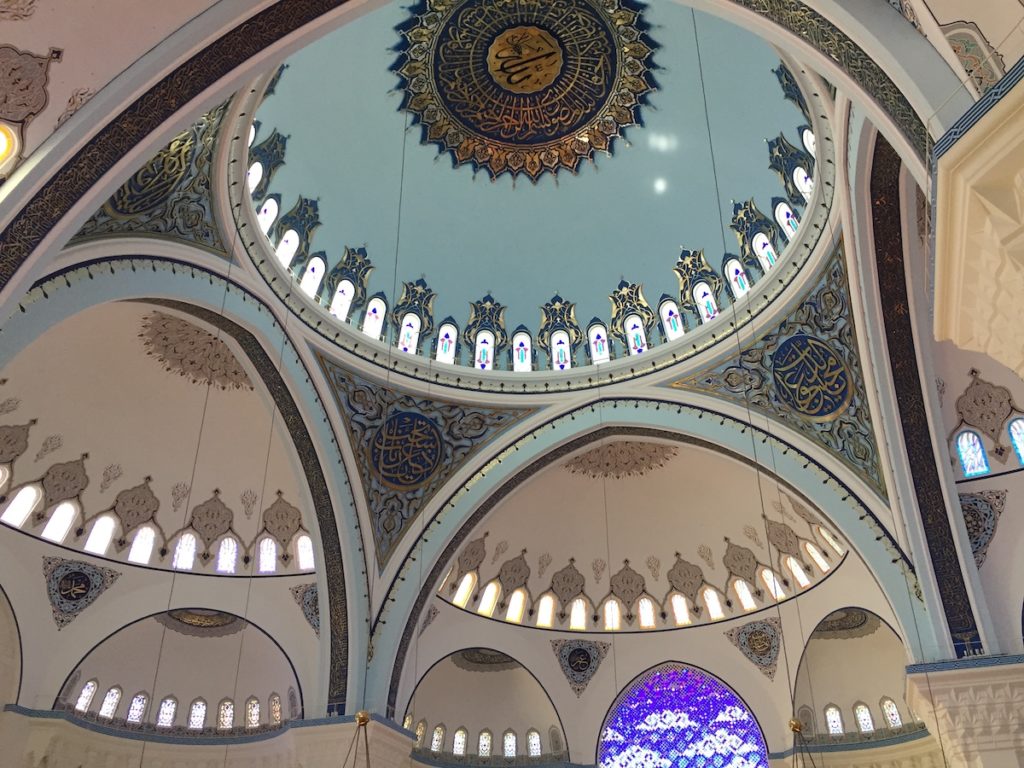
It seems that Erdoğan’s imperial nostalgia will not stop instrumentalizing architecture’s ability to transcend epochs until he is settled in Topkapi Palace and returns the capital city back to Istanbul. This is why his intervention in Hagia Sophia differs from that of his predecessors. By denying the building’s singularity as an extremely dense heritage or lieu de mémoire from which to reform and reinvent Turkish culture and politics, he seeks to turn back the clock to an imagined epoch. Erdoğan’s spite for the European Union’s rejection of Turkey’s admission to full membership underpins these maneuvers. He wanted to have his legacy associated with Turkey joining the EU, but the rejection made him turn his back to Europe, and focus on religion and Ottoman legacy instead for propagandistic purposes. Becoming European thus no longer appears to be part of his agenda. Rather, by the time the highly controversial Istanbul Canal, another gigantic multibillion-dollar project of Erdoğan is finished, the city will no longer even be part of the continent anymore. The Canal is expected to connect the Marmara Sea and the Black Sea together, but in fact will cut off the tip of the Thrace peninsula from Europe. Returning Hagia Sophia to Muslim worship is a smokescreen, deflecting attention away from these greater and even more dangerous nationalist and neoliberal schemes of not only suppressing the long history of Istanbul as a stubbornly hybrid city, but also changing the very geographical and cultural topography of the continent.
Nebahat Avcıoğlu is Associate Professor of Islamic Art and Architecture at Hunter College and affiliated faculty at the Graduate Center, CUNY.
[1] Gülru Necipoğlu, “The Life of an Imperial Monument: Hagia Sophia after Byzantium,” in The Hagia Sophia: Form, Structure and Meaning from the Age of Justinian to the Present, ed. Robert Mark and Ahmet Cakmak (Cambridge: Cambridge University Press, 1992), 195-225.
[2] Ceren Katıpoğlu and Çağla Caner-Yüksel, “Hagia Sophia ‘Museum’: A Humanist Project of the Turkish Republic,” in Constructing Cultural Identity, Representing Social Power, ed. Cânâ Bilsel, Kim Esmark, Niyazi Kžzžlyürek, and Ólafur Rastrick (Pisa: Plus-Pisa University Press, 2010), 205-225.
[3] Nur Altınyıldız, “The Architectural Heritage of Istanbul and the Ideology of Preservation,” Muqarnas 24 (2007), 281-305.
[4] Can Bilsel, “The Crisis in Conservation: Istanbul’s Gezi Park between Restoration and Resistance,” Journal of the Society of Architectural Historians 76:2 (2017), 141-145. See also Ömür Harmanşah, “The Conversion of Hagia Sophia: Desire, Spectacle, and a Historical Re-Enactment,” Berkley Forum, July 31, 2020 https://berkleycenter.georgetown.edu/responses/the-conversion-of-hagia-sophia-desire-spectacle-and-a-historical-re-enactment (accessed August 1, 2020).
[5] Nebahat Avcioğlu, ‘Towards a New Typology of Modern and Contemporary Mosque in Europe Including Russia and Turkey,’ in The Friday Mosque in the City: Liminality, Ritual and Politics, ed. A. Hilâl Uğurlu and Suzan Yalman, (Bristol and Chicago: Intellect Books, 2020), 277-312.
Cite this note as: Nebahat Avcıoğlu, “Hagia Sophia and Mosque Politics,” Journal18 (August 2020), https://www.journal18.org/5083.
Licence: CC BY-NC
Journal18 is published under a Creative Commons CC BY-NC International 4.0 license. Use of any content published in Journal18 must be for non-commercial purposes and appropriate credit must be given to the author of the content. Details for appropriate citation appear above.

